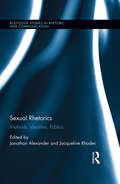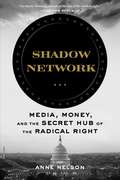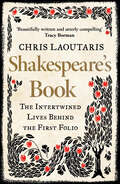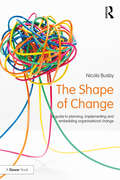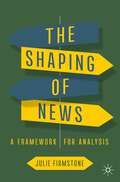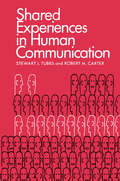- Table View
- List View
Sex Trafficking, Scandal, and the Transformation of Journalism, 1885-1917
by Gretchen SoderlundIn Sex Trafficking, Scandal, and the Transformation of Journalism, Gretchen Soderlund offers a new way to understand sensationalism in both newspapers and reform movements. By tracing the history of high-profile print exposés on sex trafficking by journalists like William T. Stead and George Kibbe Turner, Soderlund demonstrates how controversies over gender, race, and sexuality were central to the shift from sensationalism to objectivity—and crucial to the development of journalism in the early twentieth century.
Sex Trafficking, Scandal, and the Transformation of Journalism, 1885-1917
by Gretchen SoderlundIn Sex Trafficking, Scandal, and the Transformation of Journalism, Gretchen Soderlund offers a new way to understand sensationalism in both newspapers and reform movements. By tracing the history of high-profile print exposés on sex trafficking by journalists like William T. Stead and George Kibbe Turner, Soderlund demonstrates how controversies over gender, race, and sexuality were central to the shift from sensationalism to objectivity—and crucial to the development of journalism in the early twentieth century.
Sexual Rhetorics: Methods, Identities, Publics (Routledge Studies in Rhetoric and Communication)
by Jonathan Alexander Jacqueline RhodesSexual rhetoric is the self-conscious and critical engagement with discourses of sexuality that exposes both their naturalization and their queering, their torquing to create different or counter-discourses, giving voice and agency to multiple and complex sexual experiences. This volume explores the intersection of rhetoric and sexuality through the varieties of methods available in the fields of rhetoric and writing studies, including case studies, theoretical questioning, ethnographies, or close (and distant) readings of "texts" that help us think through the rhetorical force of sexuality and the sexual force of rhetoric.
Sexual Rhetorics: Methods, Identities, Publics (Routledge Studies in Rhetoric and Communication)
by Jonathan Alexander Jacqueline RhodesSexual rhetoric is the self-conscious and critical engagement with discourses of sexuality that exposes both their naturalization and their queering, their torquing to create different or counter-discourses, giving voice and agency to multiple and complex sexual experiences. This volume explores the intersection of rhetoric and sexuality through the varieties of methods available in the fields of rhetoric and writing studies, including case studies, theoretical questioning, ethnographies, or close (and distant) readings of "texts" that help us think through the rhetorical force of sexuality and the sexual force of rhetoric.
Sexual Teens, Sexual Media: Investigating Media's Influence on Adolescent Sexuality (Routledge Communication Series)
by Jane D. Brown Jeanne R. Steele Kim Walsh-ChildersThis collection explores the sexual content of U.S. mass media and its influence in the lives of adolescents. Contributors address the topic of sexuality broadly, including evidence not only about physical sex acts, but also about the role the media play in the development of gender roles, standards of beauty, courtship, and relationship norms. Chapters included here present new perspectives on what teens are paying attention to in the media, and offer insight into how teens are understanding and applying what the media present about sex and sexuality. Employing various methodological approaches, the studies also represent a diversity of adolescent audiences and deal with a wide variety of media content, ranging from teens' favorite TV programs to magazines, movies, music, and teen girls' Web pages. Taken as a whole, this volume highlights the significant roles the media play in adolescents' sexual lives. Sexual Teens, Sexual Media contributes important evidence to the ongoing debate over media effects, making it essential reading for scholars and students in media studies, as well as social and developmental psychology.
Sexual Teens, Sexual Media: Investigating Media's Influence on Adolescent Sexuality (Routledge Communication Series)
by Jane D. Brown Jeanne R. Steele Kim Walsh-ChildersThis collection explores the sexual content of U.S. mass media and its influence in the lives of adolescents. Contributors address the topic of sexuality broadly, including evidence not only about physical sex acts, but also about the role the media play in the development of gender roles, standards of beauty, courtship, and relationship norms. Chapters included here present new perspectives on what teens are paying attention to in the media, and offer insight into how teens are understanding and applying what the media present about sex and sexuality. Employing various methodological approaches, the studies also represent a diversity of adolescent audiences and deal with a wide variety of media content, ranging from teens' favorite TV programs to magazines, movies, music, and teen girls' Web pages. Taken as a whole, this volume highlights the significant roles the media play in adolescents' sexual lives. Sexual Teens, Sexual Media contributes important evidence to the ongoing debate over media effects, making it essential reading for scholars and students in media studies, as well as social and developmental psychology.
Sh**ged. Married. Annoyed.: The Sunday Times No. 1 Bestseller
by Chris Ramsey Rosie RamseyTHE HILARIOUS AND ACHINGLY RELATABLE NEW BOOK FROM CHRIS AND ROSIE RAMSEY, STARS OF THE CHART-TOPPING PODCASTThis is not a self-help book. This book contains absolutely no advice that you should follow yourself. ___________SH**GED Saturday nights out on the tiles, undying crushes, dating like it's a competitive sport, awkward tales of dating woes, one-night stands, the walk of shame, ghosting, tears and break-ups.MARRIED Finding 'the one', meeting their parents, first holidays and romantic weekends away, engagement rings, big moment proposals, wedding bells, the hen do, the stag, the much anticipated - and feared - best man speech, the honeymoon of a lifetime.ANNOYED Who stacks a dishwasher like this? Empty milk cartons placed back into the fridge, pregnancy, sleepless nights, toilet seats up, toothpaste everywhere, less and less frequent date nights, DIY weekends, divorce.Whether you're sh**ged, married, annoyed, or, all of the above, Chris and Rosie Ramsey, hosts of the number one podcast, write hilariously and with honesty about the ups and downs and ins and outs of love, sex and relationships.
Shade: A Tale of Two Presidents
by Pete SouzaAs Chief Official White House Photographer, Pete Souza spent more time alongside President Barack Obama than almost anyone else. His years photographing the President gave him an intimate behind-the-scenes view of the unique gravity of the Office of the Presidency, and the tremendous responsibility that comes with it.Now, as a concerned citizen observing the Trump administration, he is standing up and speaking out.Shade is a portrait in Presidential contrasts, telling the tale of the Obama and Trump administrations through a series of visual juxtapositions. Here, more than one hundred of Souza's unforgettable images of President Obama deliver new power and meaning when framed by the tweets, news headlines, and quotes that defined the first 500 days of the Trump White House.What began with Souza's Instagram posts soon after President Trump's inauguration in January 2017 has become a potent commentary on the state of the Presidency, and the USA. Some call this 'throwing shade'. Souza calls it telling the truth.In Shade, Souza's photographs are more than a rejoinder to the chaos, abuses of power, and destructive policies that now define America's highest office. They are a reminder of a President we could believe in, and a courageous defense of American values.
Shadow Network: Media, Money, and the Secret Hub of the Radical Right
by Anne Nelson“Reveals a political trend that threatens both our form of government and our species.” - Timothy Snyder, author of ON TYRANNY"Riveting.... Want to understand how so many Americans turned against truth? Read this book." Nancy Maclean, author of DEMOCRACY IN CHAINSThe chilling story of the covert group that masterminds the Radical Right's ongoing assault on America's airwaves, schools, environment, and, ultimately, its democracy. In 1981, emboldened by Ronald Reagan's election, a group of some fifty Republican operatives, evangelicals, oil barons, and gun lobbyists met in a Washington suburb to coordinate their attack on civil liberties and the social safety net. These men and women called their coalition the Council for National Policy. Over four decades, this elite club has become a strategic nerve center for channeling money and mobilizing votes behind the scenes. Its secretive membership rolls represent a high-powered roster of fundamentalists, oligarchs, and their allies, from Oliver North, Ed Meese, and Tim LaHaye in the Council's early days to to Kellyanne Conway, Ralph Reed, Tony Perkins, and the DeVos and Mercer families today. In Shadow Network, award-winning author and media analyst Anne Nelson chronicles this astonishing history and illuminates the coalition's key figures and their tactics. She traces how the collapse of American local journalism laid the foundation for the Council for National Policy's information war and listens in on the hardline broadcasting its members control. And she reveals how the group has collaborated with the Koch brothers to outfit Radical Right organizations with state-of-the-art apps and a shared pool of captured voter data - outmaneuvering the Democratic Party in a digital arms race whose result has yet to be decided.In a time of stark and growing threats to our most valued institutions and democratic freedoms, Shadow Network is essential reading.
Shakespeare, Italy, and Transnational Exchange: Early Modern to Present (Routledge Studies in Shakespeare)
by Enza De Francisci Chris StamatakisThis interdisciplinary, transhistorical collection brings together international scholars from English literature, Italian studies, performance history, and comparative literature to offer new perspectives on the vibrant engagements between Shakespeare and Italian theatre, literary culture, and politics, from the sixteenth to the twenty-first century. Chapters address the intricate, two-way exchange between Shakespeare and Italy: how the artistic and intellectual culture of Renaissance Italy shaped Shakespeare’s drama in his own time, and how the afterlife of Shakespeare’s work and reputation in Italy since the eighteenth century has permeated Italian drama, poetry, opera, novels, and film. Responding to exciting recent scholarship on Shakespeare and Italy, as well as transnational theatre, this volume moves beyond conventional source study and familiar questions about influence, location, and adaptation to propose instead a new, evolving paradigm of cultural interchange. Essays in this volume, ranging in methodology from archival research to repertory study, are unified by an interest in how Shakespeare’s works represent and enact exchanges across the linguistic, cultural, and political boundaries separating England and Italy. Arranged chronologically, chapters address historically-contingent cultural negotiations: from networks, intertextual dialogues, and exchanges of ideas and people in the early modern period to questions of authenticity and formations of Italian cultural and national identity in the eighteenth and nineteenth century. They also explore problems of originality and ownership in twentieth- and twenty-first-century translations of Shakespeare’s works, and new settings and new media in highly personalized revisions that often make a paradoxical return to earlier origins. This book captures, defines, and explains these lively, shifting currents of cultural interchange.
Shakespeare, Italy, and Transnational Exchange: Early Modern to Present (Routledge Studies in Shakespeare)
This interdisciplinary, transhistorical collection brings together international scholars from English literature, Italian studies, performance history, and comparative literature to offer new perspectives on the vibrant engagements between Shakespeare and Italian theatre, literary culture, and politics, from the sixteenth to the twenty-first century. Chapters address the intricate, two-way exchange between Shakespeare and Italy: how the artistic and intellectual culture of Renaissance Italy shaped Shakespeare’s drama in his own time, and how the afterlife of Shakespeare’s work and reputation in Italy since the eighteenth century has permeated Italian drama, poetry, opera, novels, and film. Responding to exciting recent scholarship on Shakespeare and Italy, as well as transnational theatre, this volume moves beyond conventional source study and familiar questions about influence, location, and adaptation to propose instead a new, evolving paradigm of cultural interchange. Essays in this volume, ranging in methodology from archival research to repertory study, are unified by an interest in how Shakespeare’s works represent and enact exchanges across the linguistic, cultural, and political boundaries separating England and Italy. Arranged chronologically, chapters address historically-contingent cultural negotiations: from networks, intertextual dialogues, and exchanges of ideas and people in the early modern period to questions of authenticity and formations of Italian cultural and national identity in the eighteenth and nineteenth century. They also explore problems of originality and ownership in twentieth- and twenty-first-century translations of Shakespeare’s works, and new settings and new media in highly personalized revisions that often make a paradoxical return to earlier origins. This book captures, defines, and explains these lively, shifting currents of cultural interchange.
Shakespeare's Bawdy (Routledge Classics)
by Eric PartridgeThis classic of Shakespeare scholarship begins with a masterly introductory essay analysing and exemplifying the various categories of sexual and non-sexual bawdy expressions and allusions in Shakespeare's plays and sonnets. The main body of the work consists of an alphabetical glossary of all words and phrases used in a sexual or scatological sense, with full explanations and cross-references.
Shakespeare’s Book: The Intertwined Lives Behind The First Folio
by Chris Laoutaris‘A lively picture of multiple operators scrambling to steal a march on the competition . . . Lavishly detailed’FINANCIAL TIMES
Shallow and Deep Learning Principles: Scientific, Philosophical, and Logical Perspectives
by Zekâi ŞenThis book discusses Artificial Neural Networks (ANN) and their ability to predict outcomes using deep and shallow learning principles. The author first describes ANN implementation, consisting of at least three layers that must be established together with cells, one of which is input, the other is output, and the third is a hidden (intermediate) layer. For this, the author states, it is necessary to develop an architecture that will not model mathematical rules but only the action and response variables that control the event and the reactions that may occur within it. The book explains the reasons and necessity of each ANN model, considering the similarity to the previous methods and the philosophical - logical rules.
The Shape of Change: A guide to planning, implementing and embedding organisational change
by Nicola BusbyNo organisations, change initiative or stakeholder is ever the same. The way business change management is shaped to work with and get the best out of every different change situation makes a vital contribution to the success of the change. The Shape of Change is the first business change management book to focus solely on the practical challenges of how to plan, implement and embed successful business change initiatives in a wide range of organisations from the business change manager’s point of view. It focuses on shaping every different change approach to take into consideration each individual situation including organisational culture, the type and impact of change the initiative, the attitudes and concerns of stakeholders and the potential for resistance within the organisation. Using a series of example change initiatives in private, public and non-profit sectors, it describes the change management journey, highlighting key points where business change management interventions are essential, and exploring how it feels to undertake business change initiatives in a wide range of situations, from communicating the initial change idea to ensuring the change is embedded and working well in business as usual. Accessible and comprehensive, The Shape of Change is relevant to anyone working in or planning organisational change.
The Shape of Change: A guide to planning, implementing and embedding organisational change
by Nicola BusbyNo organisations, change initiative or stakeholder is ever the same. The way business change management is shaped to work with and get the best out of every different change situation makes a vital contribution to the success of the change. The Shape of Change is the first business change management book to focus solely on the practical challenges of how to plan, implement and embed successful business change initiatives in a wide range of organisations from the business change manager’s point of view. It focuses on shaping every different change approach to take into consideration each individual situation including organisational culture, the type and impact of change the initiative, the attitudes and concerns of stakeholders and the potential for resistance within the organisation. Using a series of example change initiatives in private, public and non-profit sectors, it describes the change management journey, highlighting key points where business change management interventions are essential, and exploring how it feels to undertake business change initiatives in a wide range of situations, from communicating the initial change idea to ensuring the change is embedded and working well in business as usual. Accessible and comprehensive, The Shape of Change is relevant to anyone working in or planning organisational change.
Shaped By War
by Don McCullinNo other photographer in modern times has recorded war and its aftermath as widely and unsparingly as Don McCullin. After a childhood in London during the Blitz, and after the hardships of evacuation, McCullin feels his life has indeed been shaped by war.From the building of the Berlin Wall at the height of the Cold War to El Salvador and Kurdistan, McCullin has covered the major conflicts of the last fifty years, with the notable exception of the Falklands, for which he was denied access. His pictures from the Citadel in Hue and in the ruins of Beirut are among the most unflinching records of modern war. The publication of many of his greatest stories in the Sunday Times magazine did much to raise the consciousness of a generation, even if he himself now fears that photographs cannot prevent history from repeating itself. The brutality of conflict returns over and over again. McCullin here voices his despair.McCullin recounts the course of his professional life in a series of devastating texts on war, the events and the power of photography. The conclusion of the book marks McCullin’s retreat to the Somerset landscape surrounding his home, where the dark skies over England remind him yet again of images of war. Despite the sense of belonging and even contentment, for him there is no final escape.
Shaping Future 6G Networks: Needs, Impacts, and Technologies (IEEE Press)
by Emmanuel Bertin No Atilde Laquo L Crespi Thomas MagedanzShaping Future 6G Networks Discover the societal and technology drivers contributing to build the next generation of wireless telecommunication networks Shaping Future 6G Networks: Needs, Impacts, and Technologies is a holistic snapshot on the evolution of 5G technologies towards 6G. With contributions from international key players in industry and academia, the book presents the hype versus the realistic capabilities of 6G technologies, and delivers cutting-edge business and technological insights into the future wireless telecommunications landscape. You’ll learn about: Forthcoming demand for post 5G networks, including new requirements coming from small and large businesses, manufacturing, logistics, and automotive industry Societal implications of 6G, including digital sustainability, strategies for increasing energy efficiency, as well as future open networking ecosystems Impacts of integrating non-terrestrial networks to build the 6G architecture Opportunities for emerging THz radio access technologies in future integrated communications, positioning, and sensing capabilities in 6G Design of highly modular and distributed 6G core networks driven by the ongoing RAN-Core integration and the benefits of AI/ML-based control and management Disruptive architectural considerations influenced by the Post-Shannon Theory The insights in Shaping Future 6G Networks will greatly benefit IT engineers and managers focused on the future of networking, as well as undergraduate and graduate engineering students focusing on the design, implementation, and management of mobile networks and applications.
Shaping Future 6G Networks: Needs, Impacts, and Technologies (IEEE Press)
by Emmanuel Bertin Noel Crespi Thomas MagedanzShaping Future 6G Networks Discover the societal and technology drivers contributing to build the next generation of wireless telecommunication networks Shaping Future 6G Networks: Needs, Impacts, and Technologies is a holistic snapshot on the evolution of 5G technologies towards 6G. With contributions from international key players in industry and academia, the book presents the hype versus the realistic capabilities of 6G technologies, and delivers cutting-edge business and technological insights into the future wireless telecommunications landscape. You’ll learn about: Forthcoming demand for post 5G networks, including new requirements coming from small and large businesses, manufacturing, logistics, and automotive industry Societal implications of 6G, including digital sustainability, strategies for increasing energy efficiency, as well as future open networking ecosystems Impacts of integrating non-terrestrial networks to build the 6G architecture Opportunities for emerging THz radio access technologies in future integrated communications, positioning, and sensing capabilities in 6G Design of highly modular and distributed 6G core networks driven by the ongoing RAN-Core integration and the benefits of AI/ML-based control and management Disruptive architectural considerations influenced by the Post-Shannon Theory The insights in Shaping Future 6G Networks will greatly benefit IT engineers and managers focused on the future of networking, as well as undergraduate and graduate engineering students focusing on the design, implementation, and management of mobile networks and applications.
The Shaping of News: A Framework for Analysis
by Julie FirmstoneThis book provides readers with the understanding required to analyse the range of key factors that shape the production of news, and to assess their implications for the role of news and journalism in democracy. It brings existing research together under the umbrella of a central organising framework to explore how news and its production is shaped by a multiplicity of factors including the norms, values, role perceptions and ethics associated with journalism as a profession, the role of news sources, the changing character and significance of news audiences, the aims and objectives of news organisations, and the political, economic and social contexts within which news is produced. Exploring these factors in depth, using examples, and considering the changing conditions of news production, the chapters chart significant changes, challenges, and responses to provide the essential background for understanding the consequences of current transformations for the democratic qualities of news.
Shaping the Global Leader: Fundamentals in Culture and Behavior for Optimal Organizational Performance
by Henry Biggs Tom Bussen Lenny RamseyConsidering behavioral norms in their cultural contexts, this book arrives at a fully operational international leadership theory – and makes it accessible to academic and professional readers alike. Shaping the Global Leader fundamentally covers eight cultural dimensions gleaned from acclaimed international leadership scholars such as Geert Hofstede and the GLOBE study authors. Each cultural dimension is followed by interviews of renowned organizational leaders who relate their experiences in that area and each section underscores strategies for moving forward. The authors highlight critical lessons from classic behavioral psychology experiments and apply these findings to the international organizational context. This book serves as an eminently readable and enlightening handbook for those working, leading or studying interculturally. Both students and professionals in international leadership or business will be provided with clear and actionable organizational insights for an increasingly complex global landscape.
Shaping the Global Leader: Fundamentals in Culture and Behavior for Optimal Organizational Performance
by Henry Biggs Tom Bussen Lenny RamseyConsidering behavioral norms in their cultural contexts, this book arrives at a fully operational international leadership theory – and makes it accessible to academic and professional readers alike. Shaping the Global Leader fundamentally covers eight cultural dimensions gleaned from acclaimed international leadership scholars such as Geert Hofstede and the GLOBE study authors. Each cultural dimension is followed by interviews of renowned organizational leaders who relate their experiences in that area and each section underscores strategies for moving forward. The authors highlight critical lessons from classic behavioral psychology experiments and apply these findings to the international organizational context. This book serves as an eminently readable and enlightening handbook for those working, leading or studying interculturally. Both students and professionals in international leadership or business will be provided with clear and actionable organizational insights for an increasingly complex global landscape.
Shared Experiences in Human Communication
by Stewart L. TubbsA novel approach to traditional subjects, the wide variety of opinions, and the extensive introductory material lift this book out of the ordinary “readings" class, and will reward the reader with understanding and appreciation of a complex subject. This collection of 37 provocative selections on human communication shares with the reader the experience and insights of some of the best minds in the discipline. The selections for the most part deal with traditional communication topics in a novel way. For example, in the chapter on verbal communication, there is a selection on profane language; in the chapter on nonverbal communication, there is a section entitled “The Silent Language of Love”; in the chapter on small group communication, there’s the Parkinson article on laws in groups; and in the chapter on mass communication, there’s one on today’s interest in sexually oriented magazines. The entire spectrum of topics usually found in beginning courses in speech communication is here. An extensive Section Two includes discussion on the psychological and transactional analysis views of communication. A brief introduction precedes each section focusing on the key ideas of each reading. Sources include the Journal of Communication, Industry Week, Journalism Quarterly, Psychology Today, Supervisory Management, Journal of Social Issues, Harvard Business Review, and Today's Speech.
Shared Experiences in Human Communication
by Stewart L. TubbsA novel approach to traditional subjects, the wide variety of opinions, and the extensive introductory material lift this book out of the ordinary “readings" class, and will reward the reader with understanding and appreciation of a complex subject. This collection of 37 provocative selections on human communication shares with the reader the experience and insights of some of the best minds in the discipline. The selections for the most part deal with traditional communication topics in a novel way. For example, in the chapter on verbal communication, there is a selection on profane language; in the chapter on nonverbal communication, there is a section entitled “The Silent Language of Love”; in the chapter on small group communication, there’s the Parkinson article on laws in groups; and in the chapter on mass communication, there’s one on today’s interest in sexually oriented magazines. The entire spectrum of topics usually found in beginning courses in speech communication is here. An extensive Section Two includes discussion on the psychological and transactional analysis views of communication. A brief introduction precedes each section focusing on the key ideas of each reading. Sources include the Journal of Communication, Industry Week, Journalism Quarterly, Psychology Today, Supervisory Management, Journal of Social Issues, Harvard Business Review, and Today's Speech.
Shareveillance: The Dangers of Openly Sharing and Covertly Collecting Data (PDF)
by Clare BirchallIn an era of open data and ubiquitous dataveillance, what does it mean to “share”? This book argues that we are all “shareveillant” subjects, called upon to be transparent and render data open at the same time as the security state invests in practices to keep data closed. Drawing on Jacques Rancière’s “distribution of the sensible,” Clare Birchall reimagines sharing in terms of a collective political relationality beyond the veillant expectations of the state.

